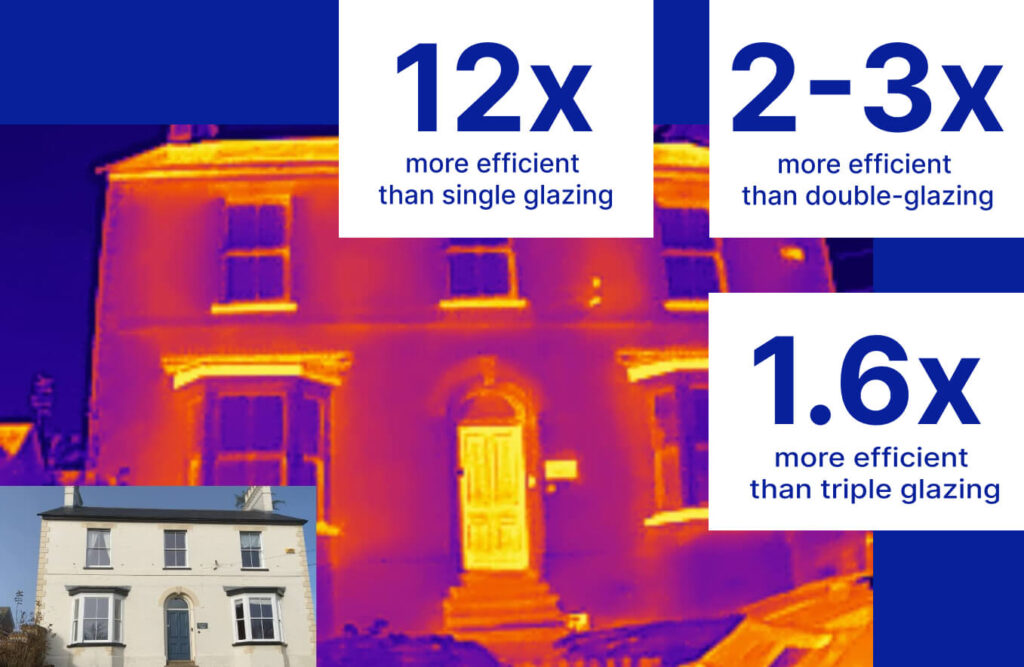
Repair or Replace Sash Windows: The Complete Comparison Guide
When faced with aging, inefficient, or damaged windows, property owners traditionally confronted a binary choice: repair what exists or replace entirely.
This seemingly straightforward decision has left countless homeowners wrestling with competing priorities—preserving the character and authenticity of their period property while achieving modern standards of energy efficiency, comfort, and performance.
The conventional wisdom suggests that window repair offers a cost-effective solution for minor issues, while replacement provides the ultimate answer for comprehensive problems.
Third option that has emerged in recent years
However, this traditional approach overlooks a third option that has emerged from advances in glazing technology and restoration techniques: window retrofit and reglazing.
This comprehensive guide explores the complete spectrum of window solutions available to modern property owners.
We’ll examine how cutting-edge technologies like Vacuum Insulated Glazing (VIG) are redefining what’s possible when it comes to preserving heritage windows while achieving—and often exceeding—the performance standards of contemporary replacements.
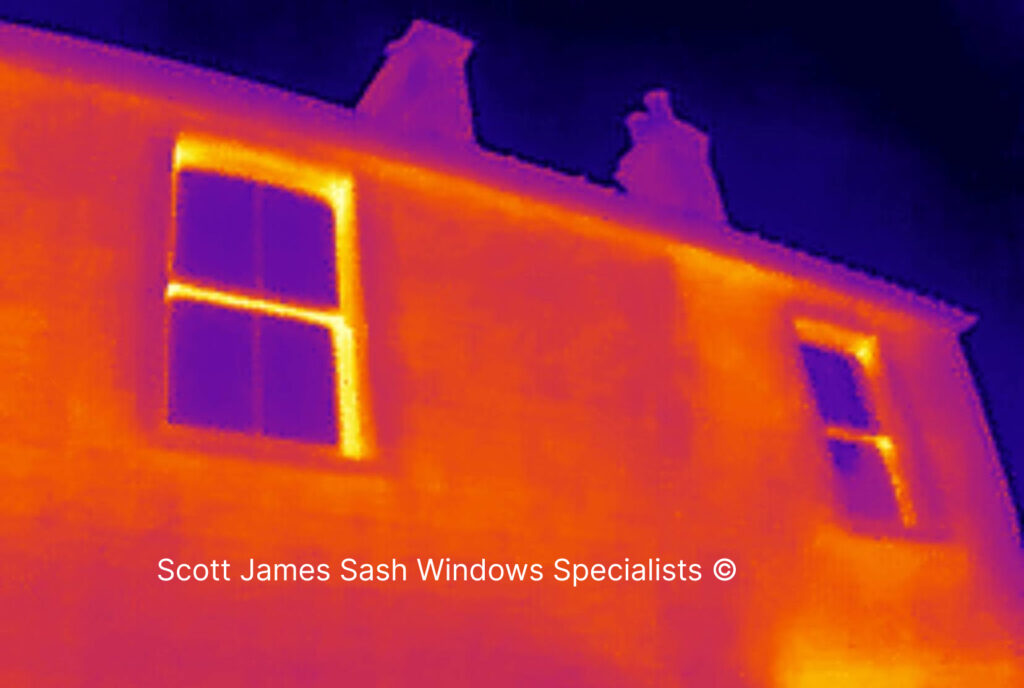
For owners of period properties, Listed buildings, and heritage homes, the stakes are particularly high. The windows of these properties aren’t merely functional elements; they’re integral to the architectural character and historical authenticity that makes these buildings special.
The challenge lies in enhancing their performance without compromising their aesthetic integrity or historical significance.
Throughout this guide, we’ll demonstrate how modern retrofit solutions can deliver the best of both worlds: preserving the irreplaceable character of original windows while incorporating state-of-the-art energy efficiency technologies.
Whether you’re dealing with draughty Victorian sash windows, single-glazed Edwardian casements, or any other period window style, this guide will equip you with the knowledge needed to choose the solution that maximises value, performance, and heritage preservation.
Understanding Your Options: Repair, Replace, or Retrofit
The landscape of window solutions has evolved dramatically over the past decade, yet many property owners remain unaware of the full range of options available to them.
Understanding these three distinct approaches—repair, replacement, and retrofit—is essential for making an informed decision that aligns with your property’s needs, budget, and long-term goals.
Traditional Window Repair & Restoration
Traditional window repair focuses on addressing specific issues while maintaining the existing window structure and glazing.
This approach typically involves fixing mechanical problems, replacing worn components, and addressing minor structural issues without fundamentally altering the window’s configuration or performance characteristics.
Common repair activities include replacing broken sash cords, repairing or replacing window hardware such as locks and handles, addressing minor frame rot through localised timber repairs, and improving draught-proofing through the installation of modern sealing systems. Paint restoration, putty replacement, and minor glazing repairs also fall under this category.
The primary advantage of traditional repair lies in its cost-effectiveness for addressing specific, localised problems.
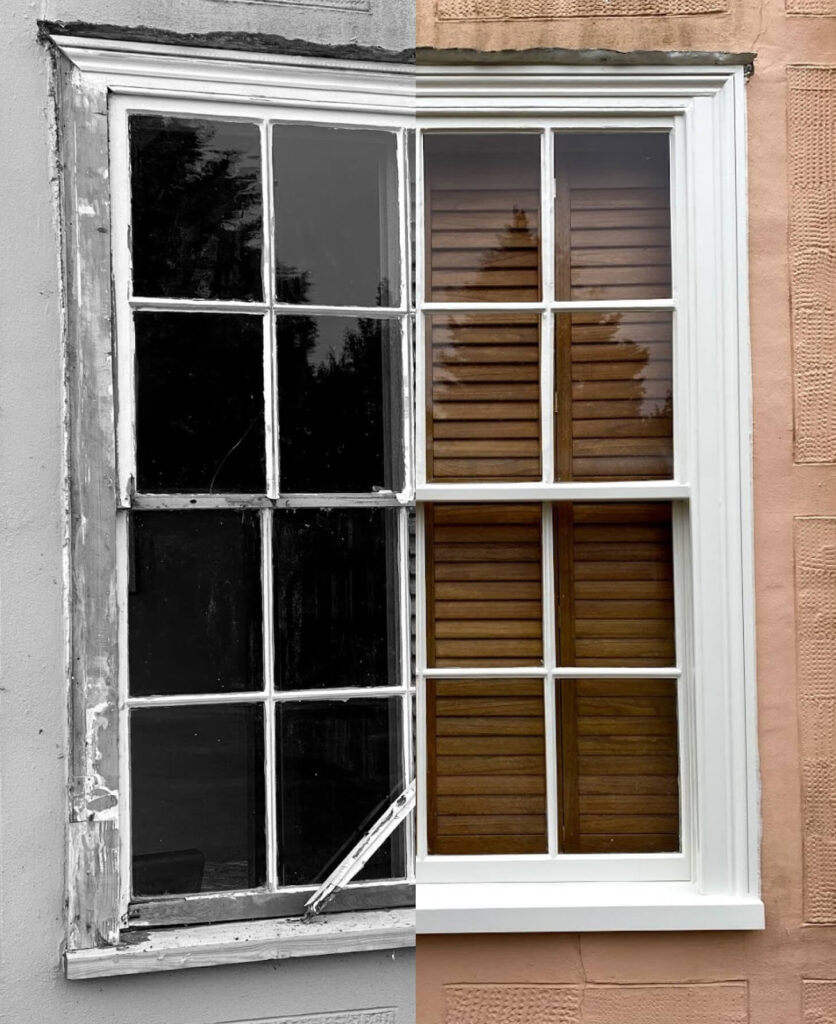
When windows are fundamentally sound but suffering from maintenance-related issues, repair can restore functionality at a fraction of the cost of replacement. This approach also preserves the original materials and craftsmanship, maintaining the authentic character that makes period properties so desirable.
However, traditional repair has significant limitations when it comes to addressing fundamental performance issues. Single-glazed windows, regardless of how well-maintained, cannot achieve the thermal efficiency standards expected in modern homes. While repairs can eliminate draughts and improve operation, they cannot address the fundamental heat loss that occurs through single-pane glass.
Complete Window Replacement
Complete window replacement involves removing the existing windows entirely and installing new units designed to meet contemporary performance standards. Modern replacement windows typically feature double or triple glazing, advanced frame materials, and sophisticated hardware systems designed for optimal energy efficiency and security.
The replacement approach offers several compelling advantages. New windows can achieve excellent thermal performance, with U-values as low as 0.8 W/m²K or better.
For properties where the existing windows are beyond economical repair or where maximum energy efficiency is the primary concern, replacement may represent the most practical solution.
However, replacement comes with significant drawbacks, particularly for period properties.
The cost of complete replacement is substantial, often representing the single largest home improvement expense many homeowners will undertake.
More critically for heritage properties, replacement fundamentally alters the character and authenticity of the building.
Even the highest-quality reproduction windows cannot perfectly replicate the proportions, glazing patterns, and subtle details that give original windows their distinctive character.
For Listed buildings and properties in Conservation Areas, replacement may require planning permission and may be refused if the proposed windows are deemed inappropriate for the building’s character.
The environmental impact of replacement is also considerable, involving the disposal of existing windows and the manufacturing of entirely new units.
Window Retrofit and Reglazing – Middle path
Window retrofit and reglazing represents a sophisticated middle path that combines the heritage preservation benefits of repair with the performance advantages of replacement.
This approach involves removing the existing glazing from original window frames and installing modern, high-performance glazing units while preserving the original frame structure and architectural details.

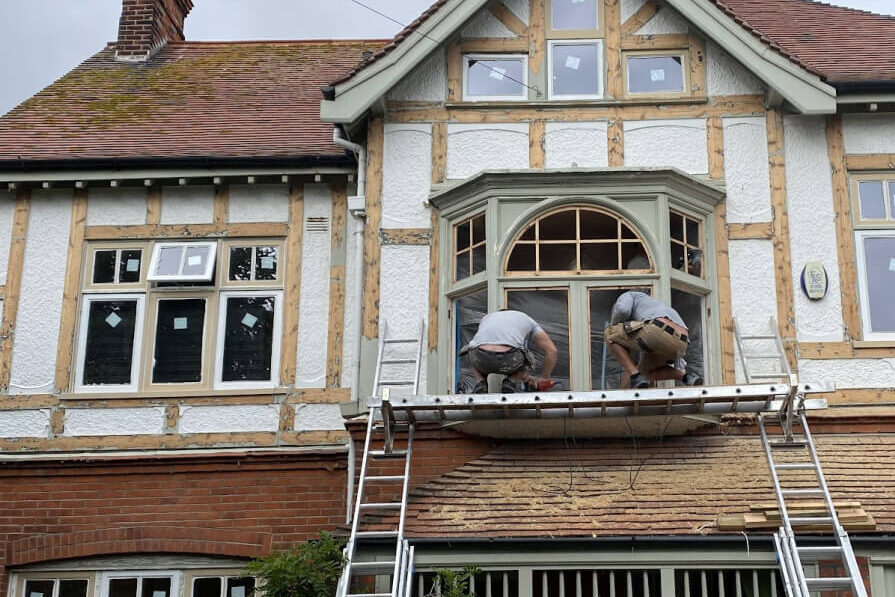
Vacuum Insulated Glazing (VIG)
The retrofit approach has been revolutionized by the development of ultra-thin, high-performance glazing technologies, particularly Vacuum Insulated Glazing (VIG). These advanced glazing systems can achieve thermal performance that matches or exceeds traditional double glazing while fitting within the narrow rebates of original window frames.
Retrofit solutions offer a unique combination of benefits that neither traditional repair nor complete replacement can match.
They preserve the original window frames, maintaining the authentic character and proportions that define period properties. The original hardware, glazing bars, and architectural details remain intact, ensuring that the building’s historical integrity is preserved.
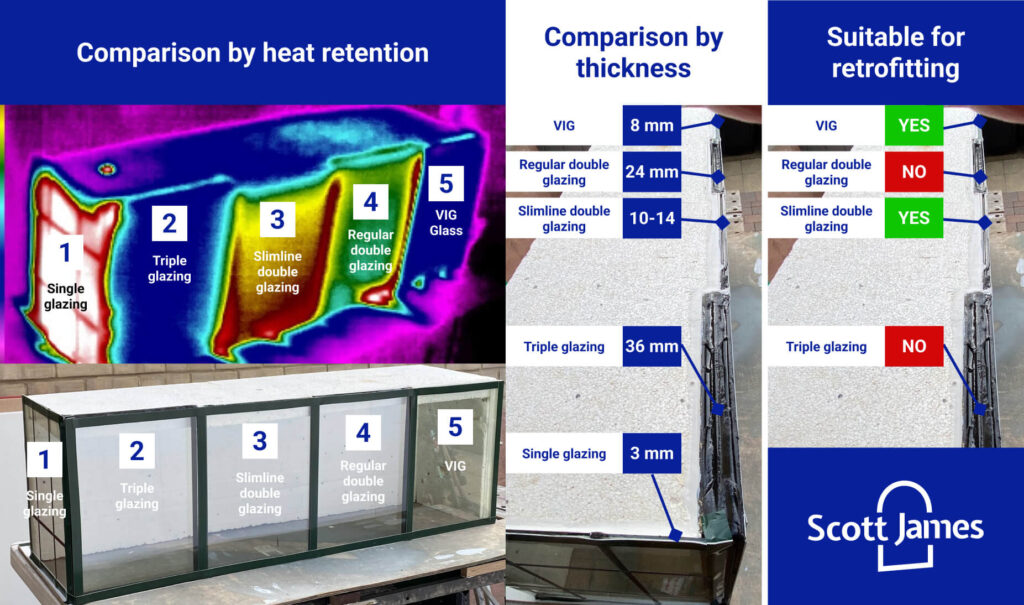
Simultaneously, retrofit delivers dramatic improvements in thermal performance, often achieving U-values of 0.4 to 0.7 W/m²K—performance levels that rival or exceed modern replacement windows.
This transformation occurs without altering the external appearance of the windows, making retrofit particularly suitable for Listed buildings and Conservation Areas where planning restrictions limit replacement options.
The retrofit approach also offers superior environmental credentials compared to replacement.
The economic advantages of retrofit
The economic advantages of retrofit are equally compelling.
While the upfront cost is higher than basic repairs, it’s typically 40-60% less than complete replacement while delivering comparable performance improvements.
The energy savings achieved through retrofit can result in significant reductions in heating costs, with many homeowners reporting 30-50% improvements in thermal comfort and energy efficiency.
When to Choose Window Repair
Sash window operation problems represent one of the most common repair scenarios.
When sash windows become difficult to open or close, the issue often stems from paint build-up, worn sash cords, or misaligned components rather than structural failure.
Functional repair – cord replacement, spring balances tension adjustment
Professional repair can restore smooth operation by replacing sash cords, adjusting the balance mechanisms, and carefully removing excess paint that impedes movement. These interventions can extend the functional life of windows by decades while preserving their original character.
Hardware replacement and upgrade represents another area where repair delivers excellent value. Original window hardware, while often beautifully crafted, may have worn beyond effective function or may lack modern security features.
Replacing locks and hardware
Replacing locks, handles, stays, and catches with high-quality reproductions or sympathetic modern alternatives can dramatically improve both security and ease of use.
The key is selecting hardware that matches the period and style of the original windows while incorporating contemporary functionality.
Rot repair / window sill replacement
Frame repairs can address timber deterioration without requiring wholesale replacement.
When rot or damage affects sections of the frame, skilled craftspeople can splice in new timber, typically using high-performance materials like Accoya wood that offer superior durability and weather resistance compared to traditional softwoods.
These repairs, when properly executed, can be virtually invisible and can extend the life of window frames by many years.
Draught-proofing
Draught-proofing improvements represent one of the most cost-effective repair interventions available.
Modern draught-proofing systems can dramatically reduce air infiltration around window frames without altering their appearance.
Professional-grade brush seals, compression seals, and weather stripping can be installed in ways that are completely invisible when windows are closed, yet deliver substantial improvements in comfort and energy efficiency.
Regular maintenance – painting
Paint restoration and protective treatments can address both aesthetic and preservation concerns.
Properly prepared and applied paint systems not only restore the appearance of period windows but also provide essential protection against weather damage.
Modern paint technologies offer improved durability and weather resistance while maintaining the authentic appearance that period properties require.
Limitations of the Repair Approach
While repair can address many specific issues effectively, it’s important to recognise the fundamental limitations of this approach, particularly regarding thermal performance.
The most significant limitation is that repair cannot address the inherent thermal inefficiency of single glazing, which represents the primary source of heat loss in most period windows.
Single-glazed windows, regardless of how well-maintained, typically have U-values of 5-6 W/m²K, compared to modern building regulations that require windows to achieve 1.6 W/m²K or better.
This means that even perfectly repaired single-glazed windows will continue to lose heat at rates that are three to four times higher than acceptable modern standards. In an era of rising energy costs and increasing environmental awareness, this limitation represents a significant ongoing cost and comfort issue.
When Window Replacement is Necessary
While retrofit solutions have expanded the range of situations where original windows can be preserved and upgraded, there remain circumstances where complete window replacement represents the most practical or necessary solution.
Understanding these scenarios helps property owners make informed decisions and avoid investing in preservation efforts that may not deliver satisfactory long-term results.
Structural Failure and Irreparable Damage
The most clear-cut case for window replacement occurs when the structural integrity of the window frame has been compromised beyond economical repair. This typically manifests as extensive rot that affects the primary structural members of the frame, particularly the sill, jambs, or head sections that bear the weight of the glazing and provide the essential weatherproofing barrier.
When rot extends through more than 50-70% of the frame’s cross-sectional area, or when it affects multiple structural elements simultaneously.
Severe impact damage represents another scenario where replacement may be unavoidable. Windows that have suffered significant structural damage from accidents, extreme weather events.
While skilled craftspeople can address remarkable levels of damage, there comes a point where the extent of reconstruction required essentially amounts to building a new window within the existing opening.
Fire damage presents particular challenges for window preservation.
Fundamental Design Limitations
Some period windows suffer from fundamental design characteristics that limit their suitability for modern use, regardless of their condition. These limitations may relate to security, accessibility, building regulation compliance, or practical functionality that cannot be addressed through repair or retrofit alone.
Extremely narrow glazing rebates in some early period windows may not accommodate even the thinnest modern glazing systems.
Building Regulation and Planning Requirements
Certain building projects trigger requirements for window upgrades that may necessitate replacement rather than retrofit.
When properties undergo major renovations, extensions, or changes of use, building regulations may require all windows to meet current thermal performance standards. While retrofit can often achieve these standards, specific circumstances may favor replacement.
Third Option: Double Glazing Retrofit – reglazing
The emergence of double glazing retrofit as a viable alternative to traditional repair or complete replacement represents one of the most significant developments in window technology and heritage preservation in recent decades.
This innovative approach bridges the gap between preserving historical authenticity and achieving modern performance standards, offering property owners a solution that was simply not available to previous generations.

What is Glazing Retrofit?
Double glazing retrofit, also known as reglazing or glass replacement, involves the careful removal of existing single glazing from original window frames and the installation of modern, high-performance glazing units within the preserved frame structure.
This process maintains the original window frame, hardware, and architectural details while dramatically improving thermal performance, comfort, and energy efficiency.
The retrofit process begins with a detailed assessment of the existing windows to determine their suitability for glazing upgrade. This evaluation considers the condition of the frame, the dimensions of the glazing rebates, the structural integrity of the glazing bars, and the overall architectural significance of the windows.
Not all windows are suitable for retrofit, but the vast majority of period windows can be successfully upgraded using appropriate techniques and materials.
The actual retrofit process involves several carefully coordinated steps.
The Technology Behind Modern Retrofit
The feasibility of double glazing retrofit has been revolutionised by advances in glazing technology, particularly the development of ultra-thin, high-performance glazing systems.
Traditional double glazing units, with overall thicknesses of 20-28mm, simply cannot fit within the narrow rebates of most period windows, which were designed to accommodate single panes of 3-6mm thickness.
The breakthrough came with the development of Vacuum Insulated Glazing (VIG), which achieves the thermal performance of traditional double glazing in a unit thickness of just 6-8mm. This dramatic reduction in thickness makes it possible to install high-performance glazing in virtually any period window frame, regardless of the original rebate dimensions.
VIG technology works by creating a vacuum between two panes of glass, eliminating the air or gas that would normally provide insulation in traditional double glazing.
Since a vacuum cannot conduct heat, this approach provides excellent thermal insulation while maintaining an extremely thin profile. The vacuum is maintained by a hermetic edge seal and tiny support pillars that prevent the glass panes from collapsing together under atmospheric pressure.
The thermal performance of VIG glazing is remarkable, with U-values typically ranging from 0.4 to 0.7 W/m²K depending on the specific product and configuration.
This performance matches or exceeds that of traditional double glazing and approaches the performance of triple glazing, yet in a package thin enough to fit within original window frames.
Beyond thermal performance, VIG glazing offers additional benefits that make it particularly suitable for retrofit applications.
The acoustic performance is excellent, providing significant noise reduction compared to single glazing. The glazing is also highly resistant to condensation, eliminating the internal condensation problems that often plague single-glazed windows in heated buildings.
Benefits of Retrofit vs Traditional Approaches
The retrofit approach offers a unique combination of benefits that neither traditional repair nor complete replacement can match. From a heritage preservation perspective, retrofit maintains the authentic character and historical integrity of period windows while delivering modern performance. This is particularly important for Listed buildings and properties in Conservation Areas, where planning restrictions may limit or prevent window replacement.
The visual impact of retrofit is minimal, with the external appearance of windows remaining virtually unchanged. This preservation of authentic appearance is crucial for maintaining the architectural coherence of period buildings and ensuring that improvements don’t compromise the property’s character or value.
Many retrofit installations are so subtle that they’re undetectable to casual observation, yet they deliver transformational improvements in comfort and efficiency.

From a performance perspective, retrofit can achieve thermal efficiency levels that rival or exceed modern replacement windows.
The comfort improvements delivered by retrofit are immediately noticeable. Eliminating cold spots near windows, reducing draughts, and minimising condensation can transform the usability of rooms, particularly during winter months.
Many property owners report that rooms become comfortable to use year-round for the first time, with significant improvements in both thermal comfort and acoustic comfort.
Energy cost savings represent another significant benefit of retrofit. The improved thermal performance typically results in 20-30% reductions in heating costs for the affected rooms, with payback periods often ranging from 8-15 years depending on energy prices and usage patterns. As energy costs continue to rise, these savings become increasingly significant over the lifetime of the windows.
The environmental benefits of retrofit are substantial compared to replacement. By preserving existing window frames and only replacing the glazing, retrofit minimizes waste and reduces the environmental impact associated with manufacturing entirely new windows.
This approach aligns with growing awareness of the importance of preserving embodied energy in existing buildings and reducing the construction industry’s environmental footprint.
Suitability Assessment for VIG Retrofit: Comprehensive Evaluation Guide
The excellent news for property owners is that most wooden windows can be successfully retrofitted with VIG glazing. Modern vacuum glazing technology has revolutionized retrofit possibilities, making it feasible for the vast majority of period windows to achieve contemporary thermal performance while preserving their original character.
Universal Compatibility: The 40mm Rule
All window frames with 40mm or greater rebate depth can accommodate VIG retrofit without modification. This covers approximately 85-90% of all wooden windows manufactured from the Georgian period onwards. The ultra-thin profile of VIG glazing (6.7mm for Fineo, 8.3mm for LandVac) means that even windows with relatively shallow rebates can be successfully upgraded.
Acceptable Condition Parameters
•Minor timber deterioration can be addressed during retrofit process
•Surface rot and weathering are typically repairable within retrofit scope
•Loose joints can be reinforced using traditional joinery techniques
•Paint deterioration and minor glazing bar damage are easily rectified
Addressing Common Concerns
Property owners considering sash window reglazing often have concerns about the impact on window operation, authenticity, and long-term performance. Understanding how these concerns are addressed can help inform decision-making and set appropriate expectations for the reglazing process.
Weight and balance concerns
Weight and balance concerns are among the most common questions about sash window reglazing.
While modern glazing units are heavier than single glazing, the weight increase is typically modest and can be accommodated through adjustments to the counterweight system.
Experienced specialists can calculate the required adjustments and implement them without compromising the smooth operation that characterises well-maintained sash windows.
Cost Analysis: Repair vs Replace vs Retrofit
Understanding the true cost implications of different window upgrade approaches requires analysis that extends beyond simple upfront expenditure to consider long-term value, energy savings, maintenance requirements, and property value impacts.
This comprehensive cost analysis provides the detailed financial information needed to make informed decisions about window investments.
Upfront Cost Comparison
The initial investment required for different window approaches varies significantly, with traditional repair representing the lowest upfront cost and complete replacement typically requiring the highest initial expenditure. However, these simple comparisons can be misleading without consideration of the scope of work and long-term value delivered by each approach.
Frame refurbishment and localised repairs
Traditional window repair costs typically range from £200-800 per window, depending on the extent of work required and the complexity of the window design. Basic repairs such as sash cord replacement, hardware adjustment, and minor frame repairs fall at the lower end of this range, while more extensive work involving timber repairs, complete hardware replacement, and comprehensive draught-proofing approaches the higher end.
Double glazing retrofit costs
Double glazing retrofit costs typically range from £800-1,500 per window for standard configurations, with complex or large windows potentially costing more.
This cost includes the removal of existing glazing, any necessary frame preparation work, the supply and installation of new VIG units, and the completion of weatherproofing and finishing work. The cost variation reflects differences in window size, complexity, glazing specifications, and the extent of preparatory work required.
The retrofit cost structure includes several components that provide long-term value beyond the immediate glazing upgrade. Frame restoration and repair work completed as part of the retrofit process can extend the service life of the windows by decades.
Complete window replacement
Complete window replacement costs vary enormously depending on the quality and specification of the new windows, but typically range from £2500-3,000 per window.
The replacement approach often involves additional costs that may not be immediately apparent.
Structural modifications to accommodate new windows, redecoration of surrounding areas, and potential planning application fees can add significantly to the total project cost.
Environmental Impact: Sustainability of Retrofit vs Replacement
The environmental implications of window upgrade decisions extend far beyond immediate energy efficiency improvements to encompass manufacturing impacts, waste generation, transportation requirements, and long-term sustainability considerations. Understanding these broader environmental factors is increasingly important for property owners who want to minimise their environmental footprint while improving building performance.
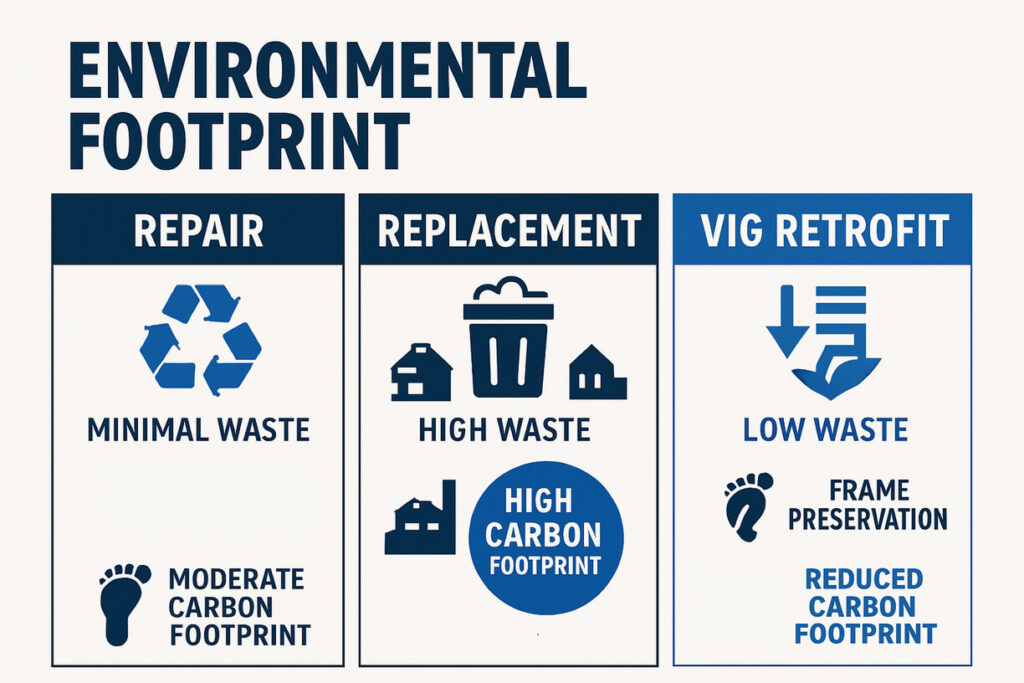
Embodied Energy and Carbon Considerations
The concept of embodied energy—the total energy required to manufacture, transport, and install building materials—provides crucial context for evaluating the environmental impact of different window approaches. This analysis reveals that the environmental benefits of window upgrades depend not only on operational energy savings but also on the environmental costs of the intervention itself.
Traditional window replacement involves substantial embodied energy in the manufacturing of entirely new window units.
Timber replacement windows require energy for forestry operations, timber processing, joinery manufacturing, hardware production, and glazing manufacture. Even when sustainably sourced timber is used, the total embodied energy can be substantial, particularly for high-quality windows suitable for heritage properties.
The disposal of existing windows during replacement projects represents a significant waste stream that often receives insufficient attention in environmental assessments.
Traditional timber windows, while theoretically recyclable, often end up in landfill due to the presence of lead paint, putty compounds, and mixed materials that complicate recycling processes.
The environmental cost of waste disposal adds to the overall impact of replacement approaches.
Conclusion
This comprehensive analysis demonstrates that the traditional binary choice between repair and replacement has evolved into a spectrum of solutions, with retrofit approaches offering compelling advantages for many heritage properties.
The Retrofit Revolution
The emergence of double glazing retrofit as a viable alternative to traditional approaches represents a paradigm shift in how we think about window improvements.
The development of Vacuum Insulated Glazing technology has eliminated the primary technical barrier that previously made retrofit impractical for most period windows, enabling the installation of high-performance glazing within the narrow rebates of original frames.
This technological breakthrough has profound implications for heritage property owners who previously faced the difficult choice between preserving authenticity and achieving modern performance.
Read more articles
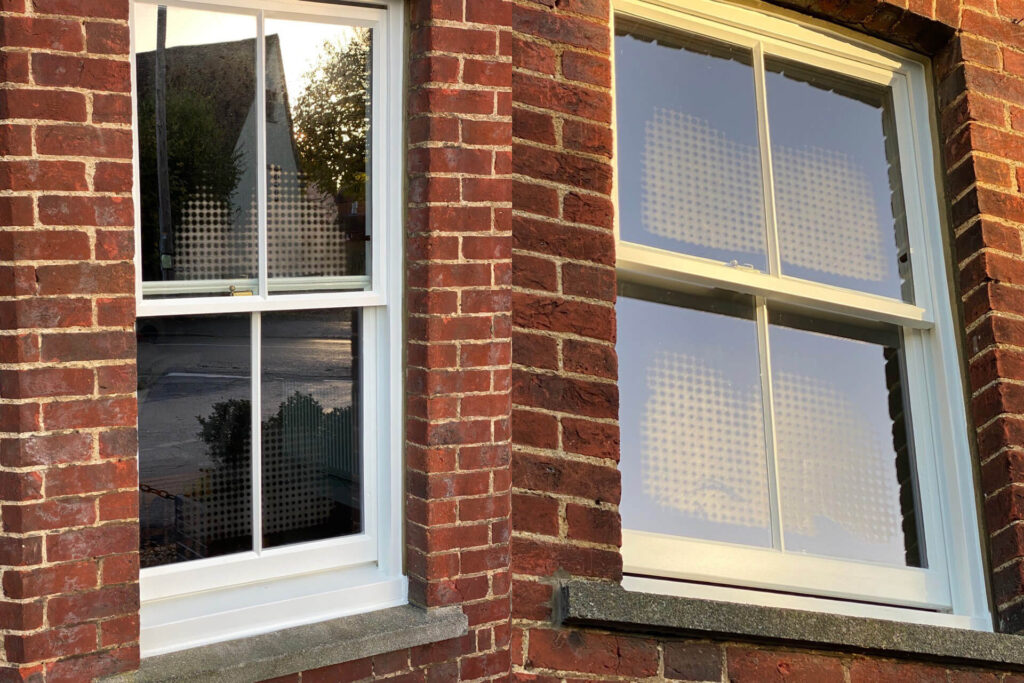
Condensation on the outside of windows
Condensation on the outside of windows
What is FENSA, and how does it affect you?
What is FENSA, and how does it affect you?
Safety glass regulations, UK
Safety glass regulations, UK
